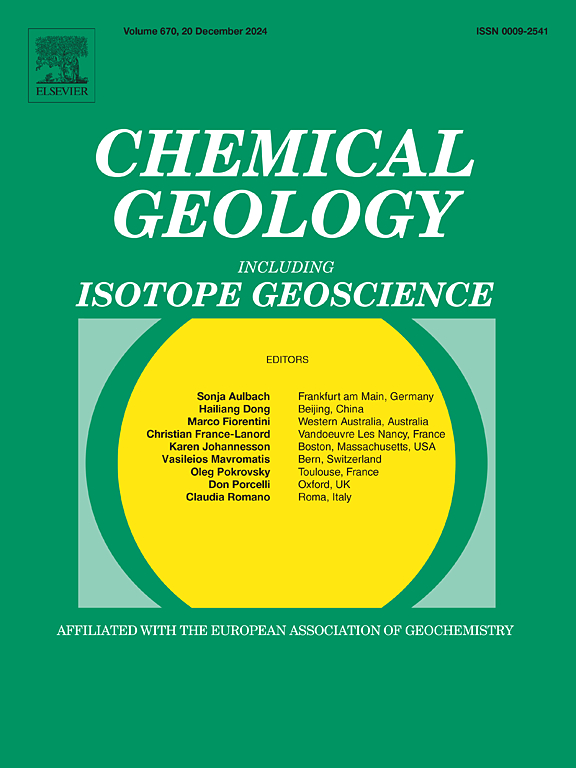前寒武纪海洋扩张中心的脆弱地质记录;重访加拿大努那维克的古元古代purtuuniq蛇绿岩片状脉杂岩
IF 3.6
2区 地球科学
Q1 GEOCHEMISTRY & GEOPHYSICS
引用次数: 0
摘要
片状脉状杂岩(SDC)是海洋扩张中心的原始记录,脉状脉为轴向岩浆室上方的裂隙火山活动提供补给。对它们的认识为地球历史上不同板块边界的海洋地壳增生提供了明确的限制。然而,前寒武纪scs的鉴定往往依赖于野外观测,而它们与上覆玄武岩和下伏辉长岩的同质性和共长性仍未得到解决。在这里,我们研究了位于加拿大Ungava造山带的Watts群(2.0 Ga)的SDC,并将其解释为海洋中脊最古老的明确遗迹,即“purtuuniq蛇绿岩”。基性岩脉的主要钙碱性亲和力与拉斑岩寄主辉长岩和玄武岩形成对比,排除了同质性。对岩脉锆石进行SHRIMP UPb定年,发现太古宙古岩芯(2981±19 Ma至2663±17 Ma)被变质边缘(1815±11 Ma)覆盖。太古宙遗传颗粒的存在与长英质污染的地球化学指标一致。我们得出的结论是,这些岩脉不代表SDC,而是一个孤立的、岩石成因无关的岩脉阵列,侵入瓦茨群。因此,“Purtuniq蛇绿岩”仅由玄武岩和辉长岩组成,这些玄武岩和辉长岩可能是Minto-Povungnituk大火成岩省(LIP)的一部分,而不是在扩张中心形成的海洋地壳的残余物。对19个可能的850 Ma以前含sdc蛇绿岩的回顾表明,没有明确的证据表明古老sdc形成于现代型海洋扩张中心。本文章由计算机程序翻译,如有差异,请以英文原文为准。
The tenuous geological record of Precambrian oceanic spreading centers; revisiting the Paleoproterozoic Purtuniq ophiolite sheeted dike complex, Nunavik, Canada
Sheeted dike complexes (SDC) are primary records of oceanic spreading centers, where dikes feed fissural volcanism above axial magma chambers. Their recognition provides unequivocal constraints on oceanic crust accretion at divergent plate boundaries through Earth's history. However, the identification of Precambrian SDCs has often hinged on field observations while their cogeneticity and coevality with the overlying basalt and underlying gabbro remain unaddressed. Here, we examine the SDC of the Watts Group (2.0 Ga), located in the Ungava Orogen (Canada) and interpreted as the oldest unequivocal remnant of a mid-ocean ridge, the ‘Purtuniq ophiolite’. The dominant calc-alkaline affinity of the mafic dikes contrasts with the tholeiitic host gabbro and basalt, ruling out cogeneticity. SHRIMP U![]() Pb dating of zircon from a dike yields an older Archean population from inherited cores (2981 ± 19 Ma to 2663 ± 17 Ma) overgrown by metamorphic rims (1815 ± 11 Ma). The presence of Archean inherited grains in the dikes is consistent with geochemical indicators of contamination by a felsic component. We conclude that the dikes do not represent a SDC but rather an isolated, petrogenetically unrelated dike array intruding the Watts Group. The ‘Purtuniq Ophiolite’ is thus only comprised of basalt and gabbro that are likely part of the Minto-Povungnituk Large Igneous Province (LIP) and does not represent a remnant of oceanic crust formed at a spreading center. A review of 19 possible cases of pre-850 Ma SDC-bearing ophiolites shows there is no definitive evidence for old SDCs formed in a modern-style oceanic spreading center.
Pb dating of zircon from a dike yields an older Archean population from inherited cores (2981 ± 19 Ma to 2663 ± 17 Ma) overgrown by metamorphic rims (1815 ± 11 Ma). The presence of Archean inherited grains in the dikes is consistent with geochemical indicators of contamination by a felsic component. We conclude that the dikes do not represent a SDC but rather an isolated, petrogenetically unrelated dike array intruding the Watts Group. The ‘Purtuniq Ophiolite’ is thus only comprised of basalt and gabbro that are likely part of the Minto-Povungnituk Large Igneous Province (LIP) and does not represent a remnant of oceanic crust formed at a spreading center. A review of 19 possible cases of pre-850 Ma SDC-bearing ophiolites shows there is no definitive evidence for old SDCs formed in a modern-style oceanic spreading center.
求助全文
通过发布文献求助,成功后即可免费获取论文全文。
去求助
来源期刊

Chemical Geology
地学-地球化学与地球物理
CiteScore
7.20
自引率
10.30%
发文量
374
审稿时长
3.6 months
期刊介绍:
Chemical Geology is an international journal that publishes original research papers on isotopic and elemental geochemistry, geochronology and cosmochemistry.
The Journal focuses on chemical processes in igneous, metamorphic, and sedimentary petrology, low- and high-temperature aqueous solutions, biogeochemistry, the environment and cosmochemistry.
Papers that are field, experimentally, or computationally based are appropriate if they are of broad international interest. The Journal generally does not publish papers that are primarily of regional or local interest, or which are primarily focused on remediation and applied geochemistry.
The Journal also welcomes innovative papers dealing with significant analytical advances that are of wide interest in the community and extend significantly beyond the scope of what would be included in the methods section of a standard research paper.
 求助内容:
求助内容: 应助结果提醒方式:
应助结果提醒方式:


